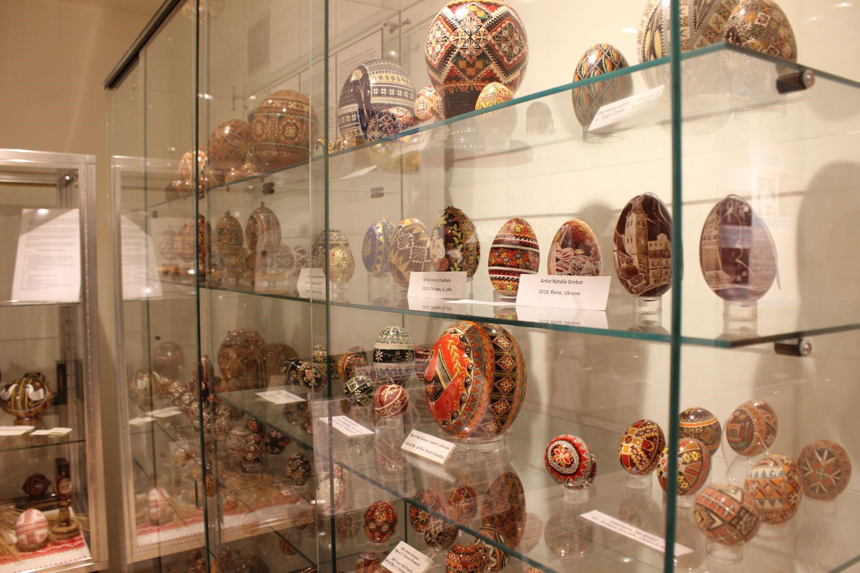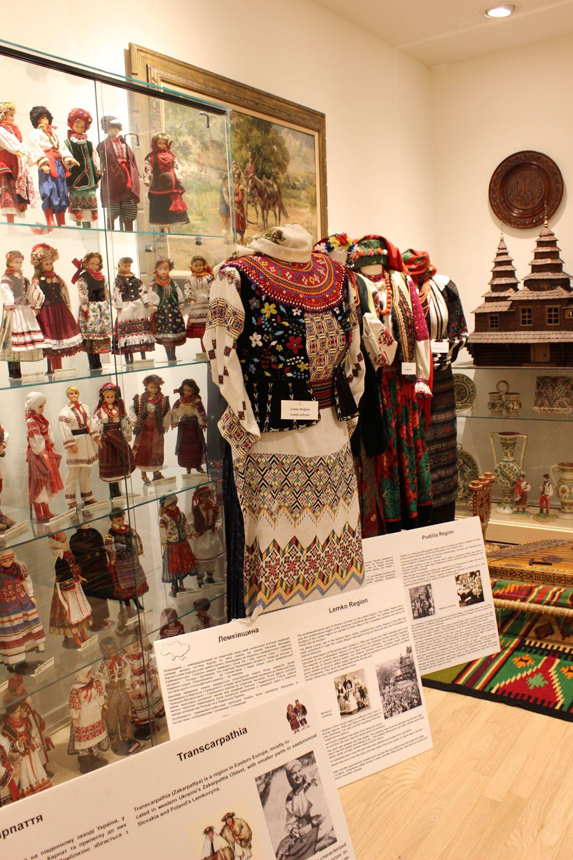Maria Klimchak, curator at the Ukrainian National Museum in Chicago, is walking through its rooms, explaining elements of the culture and history she preserves, when she comes to a favorite. It’s a small sculpture in a glass case: a Ukrainian Cossack warrior straddling a dragon and raising a club to strike the beast’s head, which bears the unmistakable likeness of Vladimir Putin.
The museum’s upcoming exhibit includes a similar display of patriotic indignation. Titled “Bridge to Independence,” it will display a collection of Ukrainian postage stamps and currency from 1917 to 2022, alongside pictures by Polish photojournalist Grzegorz Lityński of Ukraine during the current Russian invasion. The newest stamp on display will be, as museum volunteer Jerry Nestor calls it, “the F. U. stamp.” At the beginning of this year’s war, a Russian warship attacked Snake Island, a Ukrainian military outpost in the Black Sea. To Russian demands for surrender, a Ukrainian soldier famously responded, “Russian warship, go f— yourself!” That moment was commemorated by the nationwide issuance of a stamp featuring an illustrated Ukrainian soldier standing on a beach, facing a warship, and giving it the middle finger.
“[The exhibit] is going to cover that whole period of, ‘We fought; we fought; we wanted independence; we finally got it; you’re trying to take it away from us; it’s not going to happen,’” says Nestor, whose own stamp collection will be featured.
Putin justified Russia’s invasion of Ukraine in February by claiming, once again, that Ukraine never had statehood and that modern Ukraine is a Russian creation. Ukraine is fighting to the death against Russia’s attempt to realize these ideas, and at the museum, one gains an appreciation of why that is.
The upcoming exhibit begins with 1917, the year the Russian Empire fell and many Ukrainians called for independence, desiring a republic. In 1922, the Soviet Union formed, and within it, Ukraine experienced some autonomy for a few years. Under Stalin’s rule, though, the country suffered from an engineered famine that killed 3.9 million people in the 1930s. Near the end of a painful century, after the Soviet Union dissolved, Ukraine declared independence in 1991.

It was during that long-awaited year that Klimchak immigrated to the United States. She began working at the Ukrainian National Museum in 2000, and through her work and its location in Ukrainian Village, has remained connected to her country. Chicago’s Ukrainian population — second in number only to New York’s — is focused in the western part of the city and nicknamed “Ukie Village.” Murals in the neighborhood show support for Ukraine in its battle against Russia, and many apartments fly the Ukrainian flag. Klimchak’s fingernails are painted bright yellow and blue to match it.
Klimchak learned how to settle in the United States from immigrants who fled Ukraine because of the Second World War. The Village helped her build a life for her children, who were born in the States.
“You find your own way to be helpful to your own community, and then [the] community will open the door for your children. For your own dream,” Klimchak says.
She is grateful for the opportunity to be a bridge between generations of immigrants, including the wave of refugees arriving this year. At the Ukrainian National Museum, Ukrainian immigrants can experience a sense of home. Even those who are on their way to other American cities have come to the museum during layovers between flights.
“They are coming to the museum just to see what to expect in the United States; just for the advice,” Klimchak says. “Even [if] they only [just came] from Ukraine.”

When Russia attacked on February 24, the Ukrainian National Museum immediately began acting in support of their country. From March 4 to mid-April, Ukrainian artist Elena Diadenko exhibited and sold $30,000 of work through the museum, and the proceeds went to organizations helping wounded soldiers in Ukraine. The museum hosted the Lincolnwood Chamber Orchestra for two concerts and held a two-day folk art market to raise money for Ukrainian orphanages. An exhibit titled “Children of War,” co-curated by Klimchak and photographer Jerry Kykisz, displayed photographs taken by photojournalists currently working in Ukraine.
Klimchak says that some would have her stop talking about the war because of the heavy subject matter, but for her, talking is fighting.
“We will never stop talking because war has to be stopped,” Klimchak says. “Every day, I get up and sit to have a cup of coffee; I have my telephone, and [I’m] just looking that my family is still alive. This is the most difficult. Every day. Because every day, 1,000 soldiers die, and three of my nephews are in the front line.”
Unsurprisingly, this year has brought a flood of visitors to the museum. Klimchak sighs with disbelief as she recounts the first weeks of the war, when they welcomed over 200 visitors per day. Nestor’s parents immigrated to the States from Ukraine, and having grown up with their language, culture, and stories, he’s passionate about sharing Ukrainian history with the influx of museumgoers. This year, he says, many visitors have come to rediscover their Ukrainian roots. Most come to show their support for Ukraine.
“I always said to all my friends in Ukraine, to my family, how America united around us and helps us,” Klimchak says. “And the people have to understand that we are not alone. And you can feel this working in the museum. Because having everyday many people — they are only coming just to say, ‘We are standing with you. We are praying for you.’ That does not mean for myself. They are praying for Ukraine. And we appreciate this. For me, it’s a big benefit to working here.”

On July 30, the museum hosted an event organized by Sofiia Holoiad, a 19-year-old Ukrainian student of the National University of Kyiv-Mohyla Academy. She arrived in the States at the end of June and began volunteering with the Ukrainian National Museum soon after. Her event followed a meet-and-greet format, bringing together young Ukrainians and Americans to chat, listen to live music, and “create new projects and ideas for Ukraine.”
Holoiad decided to immigrate after months of trying to find her place in the war effort, feeling bereft of opportunities to help her country. She believes in the power of events that focus on human connection, and throughout the war, she has kept her people at the front of her mind.
“The thing that helped me the most during this year is my passion to stay emotional,” Holoiad says. “Not getting used to death, not getting thick-skinned and stiff, and [getting] through each death like the first time. It is about humanity. It can damage your mental health if [you] read too much news, but it protects your conscience and moral sense.”
The war has displaced many Ukrainians like Holoiad to the United States and other nations, but the fight to keep Ukraine’s independence has also pulled many immigrants back to their home country to defend it. Klimchak says one of those defenders is Dmytro Ostrovsky, who immigrated to the United States 22 years ago, graduated from law school, and joined the U.S. Navy.
“But now he went back to Ukraine to protect Ukrainian land, because he said, ‘It’s in my heart,’” Klimchak says. “He came to the museum to say, ‘Goodbye, I will be back with the victory.’”
The Ukrainian National Museum of Chicago is located at 2249 W. Superior St., Chicago, Illinois 60612. It’s open Thursday through Sunday, 11 a.m. to 4 p.m. Adult admission is $10, senior and student admission is $5, and children under 12 and members enter for free.
Become a Saturday Evening Post member and enjoy unlimited access. Subscribe now



